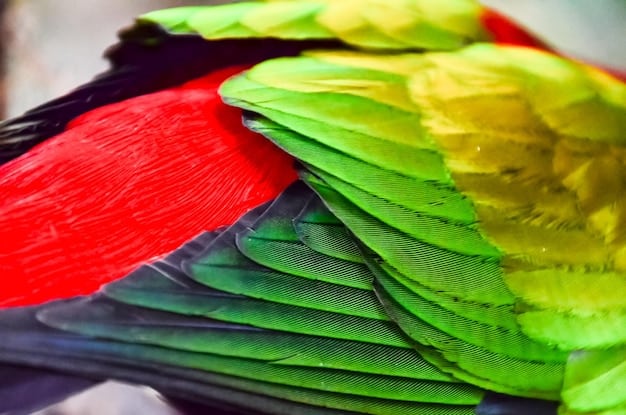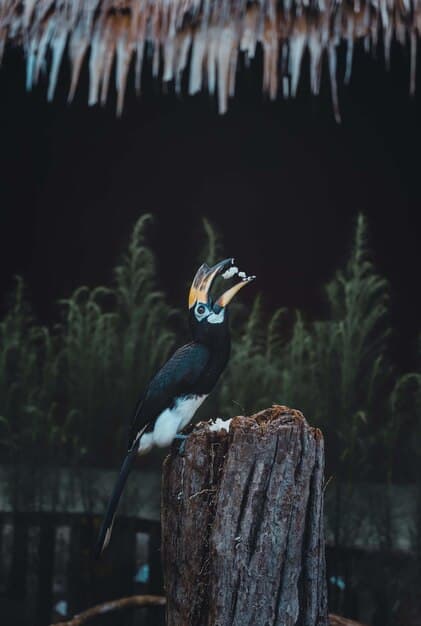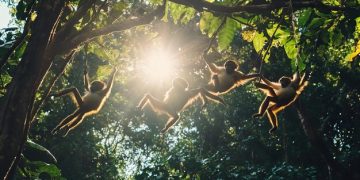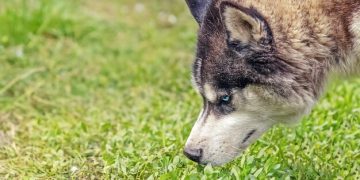Decoding Bird of Paradise Mating Rituals: A Comprehensive Guide

Animal courtship rituals, especially those of Birds of Paradise, involve elaborate displays and behaviors aimed at attracting a mate, showcasing the remarkable diversity and complexity of animal behavior in the pursuit of reproduction.
The world of animal behavior is filled with fascinating displays, and few are as captivating as the animal courtship rituals: decoding mating displays in Birds of Paradise. These vibrant creatures have evolved some of the most extravagant and complex mating dances on Earth.
Understanding Animal Courtship Rituals: The Basics
Animal courtship rituals are behaviors performed by animals to attract a mate. These rituals can involve a variety of displays, including visual, auditory, and tactile signals. In many species, the complexity and extravagance of these displays are directly related to the male’s fitness and genetic quality. Understanding this intricate dance is key to appreciating biodiversity.
The Purpose of Courtship
Courtship rituals serve several important functions. First, they allow individuals to identify potential mates of the correct species and sex. Second, they provide an opportunity for individuals to assess the quality of potential mates. Finally, they help to synchronize mating behavior, ensuring that reproduction occurs at the optimal time.
Types of Courtship Displays
- Visual Displays: These involve bright colors, intricate patterns, and elaborate movements.
- Auditory Displays: These include songs, calls, and other vocalizations used to attract mates.
- Tactile Displays: These involve physical contact, such as grooming or dancing.
Across the animal kingdom, these displays vary widely, from the subtle dances of insects to the complex performances of birds and mammals. Each display is uniquely adapted to the species and their environment, reflecting the challenges and opportunities of their particular niche.
In conclusion, animal courtship rituals are essential for successful reproduction, allowing individuals to identify, assess, and synchronize with potential mates. These rituals showcase the incredible diversity and complexity of animal behavior and contribute to the overall health and stability of ecosystems.
The Avian Wonders: Birds of Paradise Unveiled
Birds of Paradise, found primarily in New Guinea and surrounding islands, are renowned for their extraordinary plumage and elaborate courtship displays. These birds belong to the family Paradisaeidae and comprise about 45 different species, each with its unique set of characteristics and displays.
Evolutionary Significance
The extreme displays of Birds of Paradise have long fascinated scientists and naturalists. These displays are thought to be the result of sexual selection, where females choose mates based on their appearance or behavior. Over time, this has led to the evolution of increasingly elaborate and extravagant displays.
Habitat and Distribution
These birds inhabit dense rainforest environments, which provide both food and shelter. The availability of resources and the structure of the habitat play a crucial role in shaping their courtship behaviors. The males use specific areas within the forest as display grounds, where they perform for potential mates.
The diversity of Birds of Paradise extends beyond their physical appearance to their behaviors, each species exhibiting a unique set of courtship rituals. From the complex dances of the Raggiana Bird-of-Paradise to the synchronized displays of the King Bird-of-Paradise, these birds offer a glimpse into the power of sexual selection and adaptation.

Decoding Mating Dances: Visual Spectacles
Visual displays are a prominent feature of Bird of Paradise courtship rituals. Males often possess incredibly bright and colorful plumage, which they use to attract the attention of females. These displays involve complex movements and postures that highlight the male’s plumage and demonstrate his fitness.
Plumage Characteristics
- Coloration: Birds of Paradise are known for their vibrant reds, yellows, blues, and greens.
- Feather Structure: Many species have elongated or modified feathers that enhance their visual displays.
- Iridescence: The iridescent quality of their feathers adds depth and complexity to their appearance.
Specific Examples of Visual Displays
The Raggiana Bird-of-Paradise is noted for its flamboyant display involving a “wiggle dance” where the male shakes his wings and bobs his head up and down. The Lawes’s Parotia clears an area on the forest floor to create a ‘dance floor,’ where he then performs a series of stylized movements.
These visual spectacles not only attract the attention of females but also communicate important information about the male’s health and genetic quality. The brighter and more elaborate the display, the more likely the male is to secure a mate.
In summary, the visual displays of Birds of Paradise are a testament to the power of sexual selection. These displays are not merely ornamental but serve as a crucial means of communication, allowing females to make informed decisions about potential mates.
The Symphony of Sounds: Auditory Displays and Vocalizations
In addition to visual displays, Birds of Paradise also utilize auditory displays to attract mates. Their vocalizations can range from simple calls to complex songs, each serving a specific purpose in the courtship ritual. These sounds are essential for long-distance communication in the dense rainforest environment.
Types of Vocalizations
- Calls: Short, simple vocalizations used for basic communication.
- Songs: Complex sequences of notes used to attract mates or establish territory.
- Mimicry: Some species are known to mimic the sounds of other animals or the environment.
Specific Examples of Auditory Displays
The Magnificent Riflebird is known for its piercing, rifle-like call that reverberates through the forest. The Twelve-wired Bird-of-Paradise produces a series of clicking and buzzing sounds as part of its courtship display.

These auditory displays are crucial for signaling the presence of a male and attracting females from a distance. The complexity and quality of the vocalizations can also provide females with information about the male’s health and genetic quality.
In conclusion, the auditory displays of Birds of Paradise are an integral part of their courtship rituals. These vocalizations not only serve to attract mates but also communicate important information about the male’s fitness and suitability as a partner.
Beyond the Dance: Environmental and Ecological Factors
The courtship rituals of Birds of Paradise are not solely determined by genetics and sexual selection. Environmental and ecological factors also play a significant role in shaping these behaviors. The availability of resources, the structure of the habitat, and the presence of predators can all influence the way males display and females choose mates.
Resource Availability
The abundance and distribution of food resources can affect the energy levels of males and their ability to perform elaborate displays. Males that have access to high-quality food sources are more likely to be able to invest in colorful plumage and energetic dances.
Habitat Structure
The density of the forest, the presence of clearings, and the availability of perches can all influence the way males display and females observe these displays. Some species clear areas of the forest floor to create ‘dance floors,’ while others perform their displays in the canopy.
Considering these environmental and ecological factors provides a more holistic understanding of Bird of Paradise courtship rituals. These rituals are the product of a complex interplay between genetics, sexual selection, and environmental influences, highlighting the remarkable adaptations of these fascinating creatures.
Conservation Challenges: Protecting Paradise
Despite their beauty and ecological significance, Birds of Paradise face a number of conservation challenges. Habitat loss, hunting, and the pet trade all threaten the survival of these birds. Protecting their habitat and addressing these threats is essential for ensuring the long-term survival of these iconic species.
Habitat Loss
Deforestation for agriculture, logging, and mining is a major threat to Birds of Paradise. The destruction of their rainforest habitat reduces their access to food, shelter, and suitable display grounds.
Hunting and the Pet Trade
Birds of Paradise are sometimes hunted for their feathers, which are used in traditional ceremonies and sold as ornaments. The illegal pet trade also poses a threat to some species.
Conservation efforts must focus on protecting and restoring Bird of Paradise habitat, combating poaching and the illegal pet trade, and promoting sustainable livelihoods for local communities. By addressing these challenges, we can help ensure that future generations will have the opportunity to witness the beauty and wonder of these extraordinary birds.
| Key Point | Brief Description |
|---|---|
| 🌈 Visual Displays | Vibrant colors and intricate feather patterns used to attract mates. |
| 🎶 Auditory Displays | Complex songs and vocalizations used for communication and mate attraction. |
| 🌳 Environmental Factors | Resource availability and habitat structure influencing courtship behaviors. |
| 🛡️ Conservation | Protecting habitats and combating threats to ensure the survival of Birds of Paradise. |
Frequently Asked Questions
Bird of Paradise courtship rituals are unique due to their extreme complexity and the vibrant displays that males use to attract females. These displays often involve elaborate plumage and complex dances.
Females choose their mates based on a variety of factors, including the brightness and complexity of the male’s plumage, the energy and coordination of his dance, and the quality of his vocalizations.
The environment plays a significant role by influencing resource availability and habitat structure, which in turn affects the male’s ability to perform elaborate displays and the female’s ability to observe them.
The main threats to Birds of Paradise include habitat loss due to deforestation, hunting for their feathers, and the illegal pet trade, all of which threaten their long-term survival.
Conservation efforts include protecting and restoring their rainforest habitat, combating poaching and illegal trade, and promoting sustainable practices within local communities to support their preservation.
Conclusion
In conclusion, the animal courtship rituals: decoding mating displays in Birds of Paradise are among the most spectacular in the animal kingdom. These displays, shaped by sexual selection and environmental factors, highlight the beauty and complexity of animal behavior. By understanding and protecting these remarkable birds, we can ensure their survival for generations to come.





